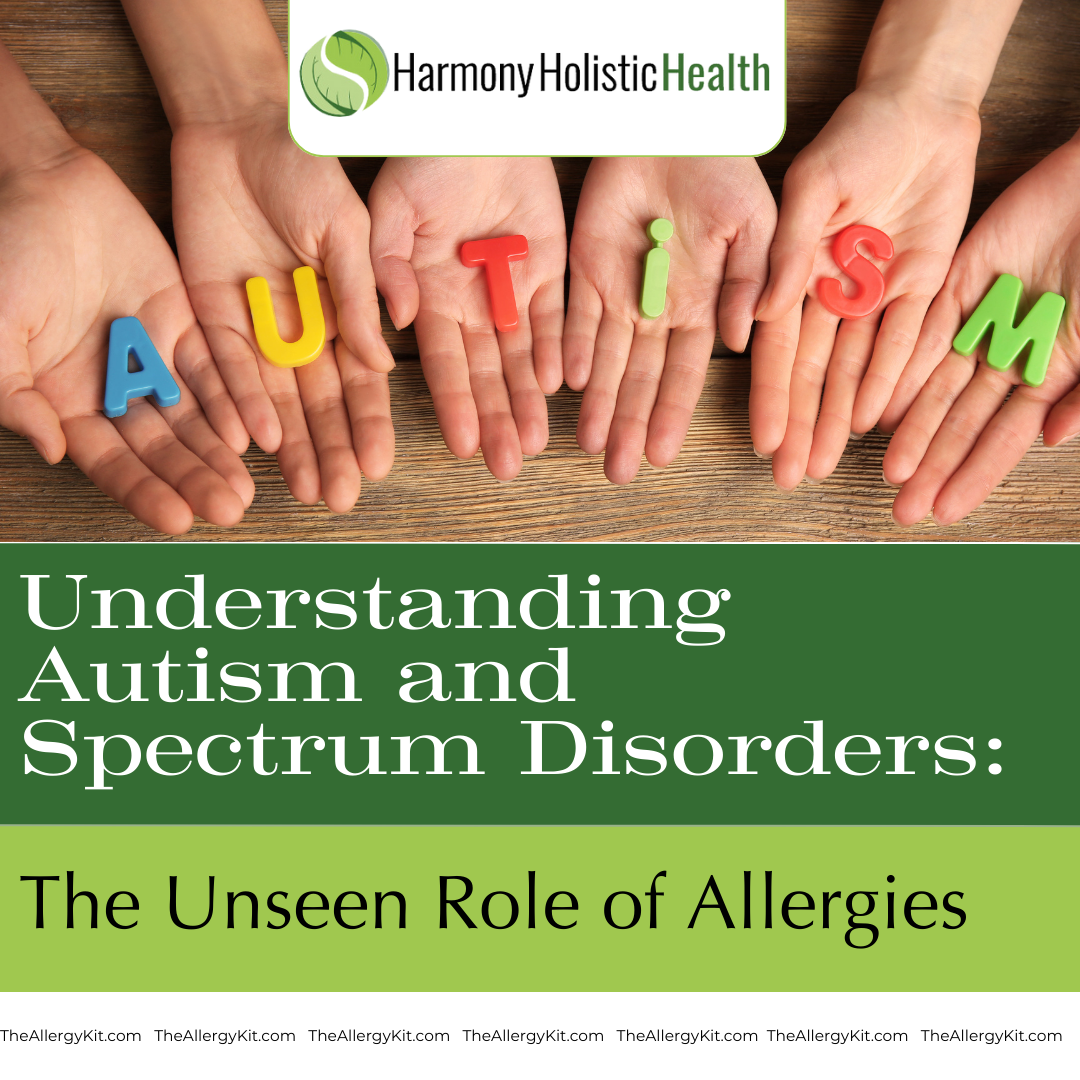
Debate over relationship between autism allergies – The debate over the relationship between autism and allergies is a complex and fascinating one. This exploration delves into the potential correlation, examining everything from the prevalence of various allergies in autistic individuals to the possible interplay between the immune system and autism. We’ll also investigate the roles of genetics, environmental factors, and diagnostic methodologies in shaping our understanding of this intricate connection.
From the differences between correlation and causation to potential confounding factors, this comprehensive look will guide you through the intricacies of this ongoing scientific discussion. Exploring the various types of allergies and their potential links, alongside diagnostic criteria and methodology, will help paint a clearer picture of the current research.
Correlation and Causation
The relationship between autism and allergies is a complex and fascinating area of research. While some studies suggest a possible link, it’s crucial to differentiate between correlation and causation. Simply observing a correlation—a tendency for two things to occur together—doesn’t automatically mean one causes the other. Many factors can influence the observed association, and further investigation is needed to understand the underlying mechanisms.Correlation, in the context of autism and allergies, means that individuals with autism may also have a higher rate of allergies compared to the general population.
Causation, however, would imply that autism directly causes allergies, or that allergies directly cause autism. It’s vital to recognize that a correlation does not equal causation. A third factor might be influencing both autism and allergies.
Potential Correlations
Numerous studies have investigated the possible correlation between autism spectrum disorder (ASD) and allergies. Some have found an association, while others have not. For instance, some studies have observed a higher prevalence of certain allergies, such as food allergies, in individuals with ASD.
Confounding Factors
Several confounding factors can influence observed associations between autism and allergies. These include genetic predispositions, environmental exposures, and variations in diagnostic criteria. Genetic factors may contribute to both autism risk and allergy susceptibility. Environmental factors, such as exposure to toxins or certain diets, might play a role in both conditions. Diagnostic criteria for autism and allergies can vary, potentially affecting the accuracy of correlation studies.
Potential Mechanisms
Possible mechanisms linking autism and allergies remain speculative and require further investigation. One potential pathway involves the immune system. The immune system plays a critical role in both conditions, and imbalances in immune responses might contribute to both autism and allergy development. Another mechanism could involve shared genetic susceptibility. Genes involved in immune function or gut development might influence both the risk of developing autism and allergies.
Examples of Studies
A study published in the Journal of Allergy and Clinical Immunology investigated the potential association between specific food allergies and ASD. The study analyzed data from a large cohort of children, comparing the prevalence of food allergies in children with ASD to a control group. Results showed a possible correlation, but further research is needed to confirm these findings.
It’s important to remember that correlation studies, while providing initial clues, don’t definitively establish a causal relationship. Additional research, including prospective studies and analyses of specific immune responses, is necessary.
Summary of Potential Links
Understanding the correlation and causation is crucial to understand potential links between autism and allergies. While some studies suggest a potential correlation, confounding factors and a lack of clear causal mechanisms make it essential to be cautious in drawing conclusions. Future research should focus on investigating potential mechanisms, including genetic predispositions, immune system imbalances, and shared environmental factors, to better understand the complex relationship between autism and allergies.
The ongoing debate about a potential link between autism and allergies is fascinating, but it often overlooks the crucial role of medical care in emergency rooms. If a child with suspected allergies experiences a reaction, rapid and appropriate treatment in a well-equipped emergency room is vital. This is where prompt diagnosis and effective interventions are paramount, ultimately impacting the overall health outcome.
Further research is still needed to solidify the link between autism and allergies, but ensuring access to high-quality medical care in emergency rooms is essential for all children, regardless of their condition. This is key in evaluating any potential allergic reactions and managing them effectively.
Prevalence and Types of Allergies: Debate Over Relationship Between Autism Allergies
Understanding the prevalence of various allergies in the general population and comparing it to the prevalence in autistic individuals is crucial for investigating potential links. While allergies are common, the specific types and their prevalence may vary across different demographics, potentially revealing patterns that could be correlated with autism. This exploration aims to shed light on the existing data, highlighting areas where further research could uncover significant insights.The prevalence of allergies in the general population is substantial, affecting a significant portion of individuals worldwide.
This high prevalence suggests a complex interplay of genetic and environmental factors. Different types of allergies, from food allergies to environmental allergies, exhibit varying degrees of prevalence, which needs to be carefully considered when evaluating potential correlations with autism.
Prevalence of Allergies in the General Population
A substantial portion of the global population experiences various types of allergies. Food allergies, particularly to common allergens like peanuts, tree nuts, milk, eggs, soy, wheat, fish, and shellfish, are prevalent across different age groups and geographic locations. Environmental allergies, such as pollen allergies and dust mite allergies, are also widespread, often leading to seasonal or persistent respiratory symptoms.
The ongoing debate about a link between autism and allergies is fascinating, but it’s important to remember that many factors influence a child’s development. While some studies suggest a potential correlation, the role of diet, especially in areas like nutrition for the elderly, is crucial to consider. For instance, quality of diet for older adults has declined heres how to fix it demonstrates how poor nutrition can affect overall health, potentially impacting a child’s well-being in unforeseen ways.
Ultimately, further research is needed to fully understand the complex interplay of various factors in the autism spectrum.
The exact prevalence rates vary depending on factors like geographic location, age, and specific allergens, but the overall picture paints a picture of widespread allergic sensitivities.
The debate surrounding autism and allergies is fascinating, but lately I’ve been more interested in the latest diet trends. Apparently, the keto diet is taking a backseat to the DASH diet on the new popularity charts, as per this recent article on the latest diet trends keto ranked low dash ranked high on new diet list. While the connection between diet and autism is still under investigation, it’s interesting to see how different dietary approaches are being evaluated.
Maybe a well-balanced diet, regardless of fad, is key to overall well-being.
Prevalence of Allergies in Autistic Individuals
Studies on the prevalence of allergies in autistic individuals have yielded mixed results. Some studies suggest a potential correlation between autism and increased rates of certain allergy types, while others fail to show a significant difference compared to the general population. The discrepancy in findings highlights the complexity of the issue and the need for more rigorous, large-scale research to determine any significant associations.
Comparison of Allergy Prevalence Between Autistic and Neurotypical Individuals
A comparative analysis of allergy prevalence between autistic and neurotypical individuals reveals inconsistencies. While some studies suggest a higher prevalence of specific allergies in autistic individuals, other studies do not find any significant difference. This variability underscores the need for further research using standardized methodologies and larger sample sizes to draw more definitive conclusions.
Specific Allergy Types Potentially Linked to Autism
Identifying specific allergy types that might be more prevalent in autistic individuals is a key area of investigation. The potential link between autism and specific allergy types could be explained by shared genetic vulnerabilities or environmental factors. However, further research is needed to validate these potential associations.
Table: Potential Link Between Allergy Types and Autism
| Allergy Type | Potential Link to Autism | Further Research Needed |
|---|---|---|
| Food Allergies (e.g., peanuts, dairy) | Some studies suggest a potential correlation, but results are inconsistent. | Larger, controlled studies are necessary to determine if a significant link exists. |
| Environmental Allergies (e.g., pollen, dust mites) | Potential correlation, but more research is required to understand the nature of the relationship. | Investigate the role of environmental exposures during early development. |
| Skin Allergies (e.g., eczema) | A potential correlation has been observed, but more research is needed to explore potential mechanisms. | Explore potential inflammatory responses and their connection to autism. |
Diagnostic Criteria and Methodology

Unraveling the intricate relationship between autism and allergies necessitates a meticulous understanding of how both conditions are diagnosed. Precise diagnostic criteria are crucial for accurate research and clinical management. This section delves into the specific diagnostic criteria, highlighting potential methodological challenges, and examining the various testing methods used for each condition.Diagnostic criteria for autism spectrum disorder (ASD) and allergies differ significantly, yet both involve complex evaluation processes.
Understanding the intricacies of these diagnostic approaches is vital for researchers and clinicians alike, to ensure robust and reliable data collection, and ultimately, to improve the lives of individuals affected by these conditions.
Diagnostic Criteria for Autism Spectrum Disorder
The diagnostic criteria for ASD are multifaceted, encompassing social communication and interaction deficits, and restricted, repetitive patterns of behavior, interests, or activities. The diagnostic process typically involves a comprehensive evaluation of developmental history, behavioral observations, and standardized assessments. Clinicians consider the severity of symptoms and their impact on daily functioning. The American Psychiatric Association’s Diagnostic and Statistical Manual of Mental Disorders (DSM-5) provides the standardized framework for diagnosing ASD.
Important aspects include:
- A detailed developmental history from parents or caregivers, encompassing milestones, communication patterns, and social interactions.
- Structured interviews and questionnaires, such as the Autism Diagnostic Observation Schedule (ADOS) and the Autism Diagnostic Interview-Revised (ADI-R), are often used to evaluate core symptoms.
- Behavioral observations in various settings, including the home, school, or clinical environment, are used to assess social interaction, communication, and repetitive behaviors.
- Standardized assessments, including cognitive tests, are sometimes used to evaluate the individual’s overall intellectual and developmental functioning.
Diagnostic Criteria for Allergies
Allergy diagnosis involves identifying the specific allergen triggering an immune response. A variety of tests are employed to pinpoint the allergen and assess the severity of the allergic reaction. This often involves a detailed history of the patient’s symptoms, including when and where the symptoms occur. Key aspects of allergy diagnosis include:
- Detailed medical history, including a thorough review of symptoms, such as skin rashes, respiratory issues, digestive problems, or anaphylaxis.
- Allergen-specific skin prick tests or blood tests, such as ImmunoCAP, to identify specific IgE antibodies to potential allergens.
- Provocative tests, such as oral food challenges, in controlled environments under medical supervision, may be necessary for certain allergies, particularly food allergies.
- Elimination diets, where specific food groups are removed from the diet, followed by careful monitoring of symptoms, may be used in conjunction with other diagnostic methods to identify triggers.
Methodological Challenges in Studying the Relationship
Numerous methodological challenges hinder the study of the correlation between autism and allergies. These include inconsistencies in diagnostic criteria, variations in testing methods, and potential biases introduced by patient selection and data collection.
- Variability in diagnostic criteria for both autism and allergies across different clinicians and healthcare systems can lead to inconsistencies in data collection.
- The presence of comorbid conditions can confound the results, making it difficult to isolate the specific effect of either autism or allergies.
- The recall bias of participants or caregivers concerning past symptoms or exposures to allergens can affect the accuracy of data collection.
Comparison of Diagnostic Approaches
The following table compares different diagnostic approaches for autism and allergies, highlighting potential biases associated with each method.
| Diagnostic Approach | Potential Biases |
|---|---|
| Autism (ADOS) | Potential for examiner bias, reliance on subjective interpretation of behavior, varying standards across different clinicians |
| Autism (ADI-R) | Reliance on caregiver report, potential for recall bias, and difficulty in assessing individuals with severe communication challenges |
| Allergy (Skin Prick Test) | Potential for false positive or negative results, dependence on the specific allergen panel, variability in skin sensitivity across individuals |
| Allergy (Blood Test) | Cost considerations, potential for false positive or negative results, limited assessment of the severity of allergic reactions |
Environmental Factors
The interplay between environmental exposures and the development of both autism spectrum disorder (ASD) and allergies is a complex area of ongoing research. Understanding how these factors might influence the relationship between the two conditions is crucial for developing effective preventative and therapeutic strategies. Environmental exposures could potentially act as either risk factors or protective factors, influencing the likelihood of both conditions developing.
Furthermore, the specific impact of environmental factors might vary significantly based on individual genetic predispositions.Environmental factors can significantly affect the development of both autism and allergies, potentially shaping the correlation between the two. Exposure to various substances and conditions during critical developmental periods may contribute to an increased risk of developing both conditions, while other factors might act as protective agents.
A comprehensive understanding of the potential role of environmental factors is essential for disentangling the complex web of influences.
Potential Environmental Influences on Autism
Numerous environmental factors are suspected to contribute to the development of autism spectrum disorder. Prenatal exposure to infections, toxins, or medications can potentially disrupt brain development, potentially increasing the risk of ASD. Postnatal exposures to environmental toxins, such as heavy metals, pesticides, and air pollutants, have also been linked to an increased risk of developing ASD. Furthermore, the quality of maternal nutrition and exposure to certain infectious diseases during pregnancy can influence the developing fetus’s neurological and immune systems, which may increase the risk of autism.
Potential Environmental Influences on Allergies
Environmental factors play a significant role in the development of allergies. Exposure to allergens, such as pollen, dust mites, and pet dander, during early childhood can trigger an immune response, potentially leading to the development of allergic conditions. Air pollution and the presence of certain chemicals in the environment can also contribute to the development of allergies. Infections during early childhood, particularly viral infections, can alter the immune system, potentially increasing the likelihood of developing allergies.
Environmental Exposures and the Relationship Between Autism and Allergies
The interplay between environmental factors and the development of both autism and allergies is not fully understood. One hypothesis is that certain environmental exposures might increase the risk of both conditions developing in individuals with a genetic predisposition. This might involve disruptions in the immune system or the developing brain. Alternatively, environmental exposures might interact with existing genetic predispositions to trigger either autism or allergies.
This hypothesis needs further investigation and may vary significantly based on individual genetic predispositions.
Comparing Environmental Impacts on Autistic Individuals with and without Allergies
Studies on the impact of environmental factors on autistic individuals with and without allergies are still limited. However, some research suggests that individuals with both ASD and allergies might experience more pronounced effects from certain environmental exposures. This could be due to a combination of factors, including the potential for heightened sensitivity to environmental triggers in individuals with both conditions.
More research is needed to fully understand the impact of various environmental factors on autistic individuals with and without allergies.
Importance of Considering Environmental Influences
Understanding the role of environmental factors in the development of both autism and allergies is crucial for developing effective prevention and intervention strategies. By investigating the interplay between environmental exposures and genetic predispositions, researchers can gain a more comprehensive understanding of the complex interplay between these conditions. This knowledge can lead to the development of targeted interventions and public health initiatives to mitigate the risks associated with environmental factors.
For example, reducing exposure to certain environmental toxins in high-risk populations could potentially reduce the incidence of both conditions.
Immune System Interactions
The intricate relationship between the immune system and the development of both autism and allergies is a complex area of research. While definitive causal links remain elusive, mounting evidence suggests a potential interplay, particularly concerning immune system dysfunction. Understanding the components of the immune system potentially involved in these conditions is crucial to unraveling the mysteries behind these disorders.The immune system, our body’s defense mechanism, is a network of cells, tissues, and organs that work together to protect us from pathogens.
This intricate system is responsible for recognizing and eliminating foreign invaders, such as bacteria and viruses. However, when this system is misdirected or dysregulated, it can lead to autoimmune diseases or, as is suspected in some cases, contribute to the development of allergies and potentially autism.
Potential Mechanisms Linking Immune System Dysfunction to Both Conditions
The immune system comprises two main arms: the innate and adaptive immune systems. The innate system provides a rapid, non-specific response to threats, while the adaptive system develops a targeted response to specific pathogens. Dysregulation in either arm, or a communication breakdown between them, might contribute to both autism and allergies.
- Innate Immune System Dysregulation: The innate immune system, the body’s first line of defense, plays a crucial role in recognizing and responding to pathogens. A compromised or overactive innate immune response could lead to chronic inflammation, which has been implicated in both autism and allergic reactions. For example, persistent inflammation in the gut, triggered by an aberrant innate response, could contribute to both allergic sensitization and neurodevelopmental issues.
- Adaptive Immune System Dysregulation: The adaptive immune system, while crucial for combating specific pathogens, can also contribute to allergic responses. An overreaction to harmless substances, like food proteins, can trigger an immune response, leading to allergic reactions. This process is known as sensitization, where the immune system learns to recognize a harmless substance as a threat. Similarly, imbalances in the adaptive immune system could be linked to the development of autoimmune responses, potentially influencing neurodevelopment in some cases.
- Immune Cell Interactions: A delicate balance of immune cells, such as T cells, B cells, and natural killer cells, is essential for a healthy immune response. Disruptions in the interaction and communication between these cells could contribute to both autism and allergies. For example, altered T cell activation patterns could lead to an inappropriate response to environmental triggers, increasing the risk of allergic reactions.
Similarly, imbalances in immune cell populations could impact brain development and function.
Immune System Components Potentially Involved
Various components of the immune system have been linked to both autism and allergies. Understanding these components and their potential roles is crucial for future research.
- Cytokines: These signaling molecules play a critical role in regulating immune responses. Imbalances in cytokine production, particularly inflammatory cytokines like TNF-α and IL-6, have been observed in both conditions. These imbalances might contribute to chronic inflammation, which could affect brain development and increase the susceptibility to allergies.
- Antibodies: These proteins are crucial for recognizing and neutralizing pathogens. Specific antibody profiles have been studied in individuals with autism and allergies. For instance, elevated levels of certain IgE antibodies, which are associated with allergic reactions, have been observed in some cases.
- Gut Microbiota: The gut microbiome, a complex community of microorganisms residing in the gut, interacts with the immune system. Alterations in the gut microbiome composition have been linked to both autism and allergies. The impact of the gut microbiome on immune system development and function remains a crucial area of investigation.
Genetic Predisposition
The intricate dance between genes and the development of both autism and allergies is a fascinating area of ongoing research. While the exact mechanisms remain somewhat elusive, evidence suggests a significant role for genetics in predisposing individuals to both conditions. Understanding these genetic underpinnings is crucial for uncovering potential shared pathways and developing targeted interventions.The human genome, a complex tapestry of DNA, holds the blueprint for countless traits and characteristics.
Within this intricate code lie genes that influence susceptibility to various diseases and conditions. The discovery of genetic variations associated with autism and allergies has fueled the exploration of potential overlaps and shared vulnerabilities. This exploration promises to illuminate the complex interplay between nature and nurture in shaping these conditions.
The Role of Genetics in Autism Development
Genetic factors play a substantial role in the development of autism spectrum disorder (ASD). Numerous studies have identified specific genes and genetic variations that increase the risk of ASD. These genes often influence brain development, synaptic function, and social communication skills. Variations in these genes can contribute to the wide range of symptoms and severity levels observed in individuals with ASD.
The Role of Genetics in Allergy Development
Genetic predisposition significantly influences the development of allergies. Individuals with a family history of allergies, such as asthma, hay fever, or eczema, have a higher likelihood of developing allergic reactions. Certain genes regulate the immune system’s response to environmental triggers, and variations in these genes can increase susceptibility to allergic diseases.
Potential Genetic Overlaps Between Autism and Allergies
Research suggests potential genetic overlaps between autism and allergies. While not a direct cause-and-effect relationship, shared genetic susceptibility to both conditions is a possibility. This shared vulnerability could stem from genes that influence immune system function or brain development pathways. Further studies are needed to fully understand the extent of these overlaps.
Shared Genetic Susceptibility to Both Conditions
The concept of shared genetic susceptibility implies that some individuals inherit a predisposition to both autism and allergies due to variations in specific genes. These genes could influence various biological processes, potentially impacting immune response and neurodevelopment. For instance, variations in genes related to immune signaling pathways could increase the risk of both conditions. The precise nature of these overlaps remains an active area of investigation.
Comparison of Genetic Pathways
| Characteristic | Autism | Allergies |
|---|---|---|
| Primary Affected Systems | Brain development, synaptic function, social communication | Immune system response to environmental triggers |
| Key Genes | Genes involved in synaptic plasticity, neurotransmitter regulation, social interaction | Genes involved in immune response, cytokine production, IgE production |
| Potential Overlapping Genes | (e.g., genes related to immune signaling, inflammation, brain development) | (e.g., genes related to synaptic plasticity, neuronal migration, social cognition) |
The genetic pathways influencing autism and allergies differ in their primary focus. Autism primarily involves genes related to brain development and function, whereas allergies focus on genes that control immune system responses. However, some genes might exert influence on both pathways. For instance, genes associated with immune signaling pathways might also contribute to neurodevelopment, leading to potential overlaps in susceptibility.
Examples of Genetic Studies
Numerous studies have investigated the genetic basis of both autism and allergies. These studies have identified specific genes and genetic variations associated with increased risk for each condition. While these studies provide valuable insights, further research is needed to fully understand the nature and extent of the potential genetic overlaps. For instance, studies have found correlations between specific genetic variations and increased likelihood of both conditions in families.
Public Health Implications

Understanding the potential link between autism and allergies has significant implications for public health. While research is still ongoing and definitive conclusions are not yet available, exploring these connections is crucial for improving diagnostic accuracy, preventive strategies, and treatment approaches. The potential benefits for individuals and society as a whole are substantial, as early intervention and tailored support can lead to improved quality of life.The implications of a confirmed link extend beyond individual patients to encompass a broader spectrum of public health concerns.
Strategies for prevention and management of allergies in children could be adapted to consider the potential interaction with autism. This could lead to earlier identification of risk factors and more effective interventions.
Potential Implications for Diagnosis
Early and accurate diagnosis of both autism and allergies is crucial for timely intervention. A potential link could necessitate modifications to existing diagnostic criteria for autism, potentially incorporating allergy history and symptoms as contributing factors. This approach could refine diagnostic tools, leading to earlier identification and more precise characterization of the condition. Moreover, improved diagnostic tools could lead to earlier interventions, which might positively impact long-term outcomes.
Potential Implications for Prevention
Identifying potential environmental triggers or predispositions could lead to proactive measures for prevention. Understanding the interplay between genetic and environmental factors is critical for developing targeted prevention strategies. For instance, if certain environmental exposures are linked to both conditions, public health initiatives could be developed to minimize exposure in vulnerable populations. This could involve public awareness campaigns, recommendations for allergen avoidance, and policies to improve indoor air quality.
Potential Implications for Treatment
Treatment approaches for both autism and allergies could be adapted to account for the potential correlation. A possible link could open avenues for developing new treatments or combining existing therapies to optimize outcomes. This may include exploring treatments that address both conditions simultaneously, rather than treating them in isolation. For example, if a particular dietary intervention is effective in reducing allergic symptoms, its impact on autistic behaviors could be evaluated.
Potential Implications for Healthcare Practices and Policies
A confirmed link could lead to significant changes in healthcare practices and policies. This necessitates the development of standardized protocols for screening, diagnosis, and treatment of both conditions. Early intervention programs tailored to address both autism and allergies could be implemented, potentially leading to improved outcomes. Moreover, healthcare providers need to be equipped with the knowledge and resources to effectively manage patients with both conditions.
| Area | Potential Implications |
|---|---|
| Screening | Development of comprehensive screening protocols for both autism and allergies in children. |
| Diagnosis | Refinement of diagnostic criteria for autism, incorporating allergy history and symptoms. |
| Treatment | Development of combined therapies targeting both autism and allergies. |
| Public Health Initiatives | Implementation of public awareness campaigns and policies to minimize exposure to potential triggers. |
Potential Impact of Research on Public Awareness and Perception, Debate over relationship between autism allergies
Research findings on the potential link between autism and allergies could significantly impact public awareness and perception of both conditions. Increased understanding of the underlying mechanisms could foster greater empathy and support for individuals affected by these conditions. This could also contribute to a more comprehensive approach to healthcare, moving beyond the treatment of individual symptoms to address the interconnectedness of various health issues.
For instance, if a strong correlation is discovered, public perception of autism could shift from being primarily viewed as a neurological disorder to a condition potentially linked to broader environmental and biological factors.
Closing Notes
Ultimately, the debate over the relationship between autism and allergies highlights the complexity of human health. While much remains unknown, the ongoing research promises to uncover more about the underlying mechanisms, and pave the way for improved diagnostic tools, preventative strategies, and potential treatments. Further research is essential to fully understand the potential links and their implications for the autistic community.





